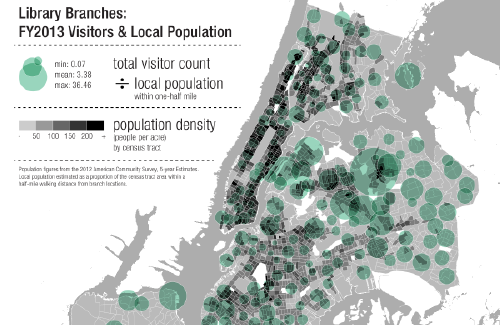Our Day: Re-Envisioning New York’s Branch Libraries
Posted February 6, 2015
New York’s appeal has often relied on that “New”– from the buildings to the people and all their latest work and play – but recently, new approaches are being pitched for a not-so-new asset: our city’s 207 public branch libraries. While our branches serve more New Yorkers in more ways than ever before, this is due partly to user-grown adaptions unique to each branch, such as ESL programming, art gallery space and a food pantry for the homeless and the disaster-afflicted. These adaptations have been useful but radical, spurring a symposium around how to go about the $1.1 billion in repairs and updates it is estimated the buildings badly need. Stakeholders in the library gathered last month to answer the event hosts’ main question: what should our community libraries offer us in the future?
Five design teams each presented concepts based on lengthy research, and response panels of diverse disciplines and backgrounds offered their feedback. Organizers began the day by asking attendees what a future library should offer us – but through discussions between librarians, politicians, designers, real estate developers, city officials and others, we realized the greater question: what should a future New York offer us?

Out of the five concepts, I was most impressed by a planning tool that can cross-reference neighborhood data to suggest optimal types of development for each branch: this would maximize the benefits and efficiency of each investment. To me, this provided the strategy missing in other presentations. The group, Marble Fairbanks with James Lima Planning + Development, Leah Meisterlin, and Special Project Office, provided examples of community data that could be included: population growth trends, racial diversity, age, flood zone vulnerability, future commercial development potential and more. By combining different data sets, stories were visualized about optimal development options – one example mapped neighborhoods gaining popularity with freelance workers against neighborhoods of populations who might need adult education. These stories suggest specific facility planning and help us see “the writing on the wall” before we spend our money and time. While every presentation had cool and helpful ideas, the symposium offered too many possible directions. This tool would help us make informed decisions about what developments could provide the most community benefit at the most efficient investment.
In thinking about strategy, there was also a trend in many presentations that seemed to beg its own discussion. Some stakeholders saw existing non-library structures (subway station space, abandoned storefronts, etc.) as blank slates, which could be renovated with bookshelves, or woodshops, or kitchens, and be adopted into the library network. While these ideas prompted helpful inquiry into what “resource access” can mean for a library, the concepts there seemed to beg their own symposium. They seemed to push the envelope too far, given how many issues we have with the existing branches and their staggering number of overdue repairs.
I urge you to join the discussion by reviewing the designs. While we do need to evolve the library model and its role in the community, I hope we don’t forget why we have our library system in the first place.


Join The Conversation